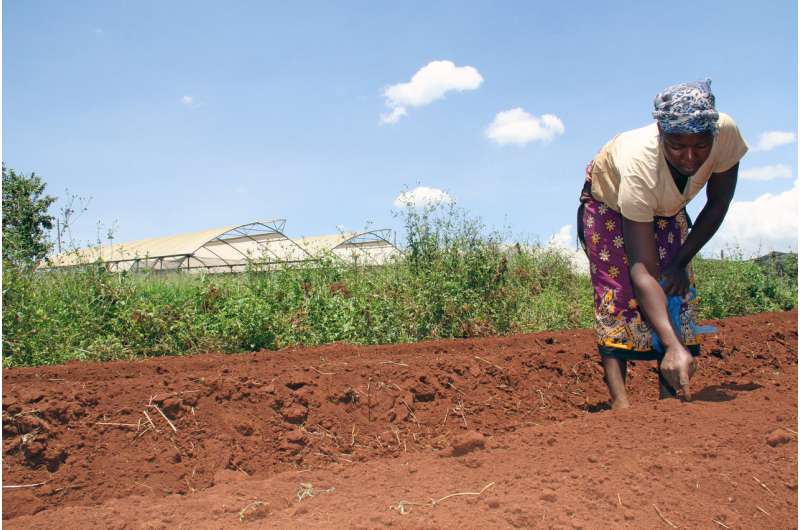Scientists call for eight steps to increase soil carbon for climate action and food security

Leading scientists call for action to increase global soil carbon, in advance of the annual climate summit of the United Nations Framework Convention on Climate Change (UNFCCC) in Katowice, Poland (COP24) and World Soil Day (5 Dec).
The amount of carbon in soil is over twice the amount of carbon found in trees and other biomass.
But one-third of the world's soils are already degraded, limiting agricultural production and adding almost 500 gigatons of carbon dioxide to the atmosphere, an amount equivalent to the carbon sequestered by 216 billion hectares of U.S. forest.
Modalities for climate action in agriculture will be addressed 3 December at the first workshop of the Koronivia Joint Work on Agriculture, a breakthrough initiative of the 2017 UNFCCC climate negotiations.
In a commentary piece, Put More Carbon in Soils to Meet Paris Climate Pledges, published today by the journal Nature, climate change and agricultural scientists who serve on the science and technical committee of the organization 4 per 1000 describe a path for recuperating soil carbon stocks to mitigate climate change and boost soil fertility. The scientists suggest that the KJWA formally commit to increasing global soil organic carbon stocks through coordination and activities related to eight steps.
The eight steps are:
1. Stop carbon loss - Protect peatlands through enforcement of regulations against burning and drainage.
2. Promote carbon uptake - Identify and promote best practices for storing carbon in ways suitable to local conditions, including through incorporating crop residues, cover crops, agroforestry, contour farming, terracing, nitrogen-fixing plants, and irrigation.
3. Monitor, report and verify impacts - Track and evaluate interventions with science-based harmonized protocols and standards.
4. Deploy technology - Use high-tech opportunities for faster, cheaper and more accurate monitoring of soil carbon changes.
5. Test strategies - Determine what works in local conditions by using models and a network of field sites.
6. Involve communities - Employ citizen science to collect data and create an open online platform for sharing.
7. Coordinate policies - Integrate soil carbon with national climate commitments to the Paris Agreement and other policies on soil and climate.
8. Provide support - Ensure technical assistance, incentives to farmers, monitoring systems, and carbon taxes to promote widespread implementation.
A joint forum for coordinated action and funding to close research gaps is needed, the scientists argue. The eight steps also inform the KJWA's next workshop (June 2019), which will address soil carbon.
"Taking steps to increase global soil carbon requires multi-stakeholder collaboration at the science-policy interface. 4p1000 initiative, which has 281 partners from 39 countries, is showing how such collaboration can be used to address sustainable development goals in an integrated way," said Cornelia Rumpel, lead author of the commentary and Research Director of the National Research Center at France's Institute of Ecology and Environmental Sciences.
Co-author Farshad Amiraslani, Remote Sensing Specialist and Deputy Dean of Academic Affairs, Faculty of Geography, University of Tehran, is concerned with how lack of coordination among stakeholders and no comprehensive database is hindering the impact of land restoration efforts. We need to apply satellite imagery to capture changes occurring at large scales more frequently and cost-effectively, he said.
"We are amassing a rich body of knowledge on how to increase soil carbon stocks," said Claire Chenu, a Professor of Soil Sciences at AgroParisTech. "But further research is needed. For example, we know root systems make an important contribution to soil carbon stocks, but we are still researching how specific crops with deep roots, vs. cover crops, vs. agroforestry systems differentially contribute to increasing soil carbon. We need more data on the effects of agricultural practices in different ecosystems."
"Challenges to achieving large-scale carbon sequestration include nutrient limits, inadequate farmer incentives and lack of organic matter in some places, but even impacts at lesser scales will benefit the climate and food security," said co-author Lini Wollenberg, Low Emissions Development Leader for the CGIAR Research Program on Climate Change, Agriculture and Food Security (CCAFS) and Research Professor at the University of Vermont's Gund Institute for Environment.
"The potential benefits are too large to ignore," Wollenberg said.
More information: Cornelia Rumpel et al, Put more carbon in soils to meet Paris climate pledges, Nature (2018). DOI: 10.1038/d41586-018-07587-4
Journal information: Nature
Provided by University of Vermont





















